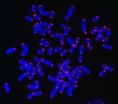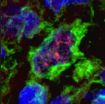Abdominal aortic aneurysm is a local area of bulge or dilatation in the abdominal aorta. If left untreated, this bulge can increase in size and—after reaching a certain size--it can burst or rupture causing fatal internal bleeding. In the United States, 9 percent of the population over the age of 65 years has an abdominal aortic aneurysm, and there are 15,000 deaths per year from ruptured abdominal aortic aneurysms. A man is four times more likely to suffer an aneurysm of this kind than a woman, and smokers are also four times as likely to develop the condition.
"People with peripheral arterial disease are at risk of an aneurysm, which is a weakening and abnormal bulging of a major artery. Once this area of bulge ruptures, this can lead to fatal internal hemorrhage," explained Prasoon Mohan, M.D., co-author of the study from the department of diagnostic and interventional radiology at Saint Francis Hospital in Evanston, Ill. "Prior to the development of minimally invasive endovascular repair, it was customary for individuals to undergo open surgery, but now the majority of these elective aneurysm repairs are being done by endovascular technique. It's only a question now of getting clinicians and institutions to use the same technique in emergency settings for ruptured aneurysms," he added.
"We found that endovascular aortic repair resulted in significantly fewer hospital deaths after treatment compared to open surgery, and the hospital stay associated with endovascular repair was less than that of open surgery," said Mohan.
Once an abdominal aortic aneurysm reaches a particular size, treatment is recommended to prevent its rupture. An abdominal aneurysm can be treated by open surgery or by minimally invasive endovascular technique. Open surgery requires a large incision in the abdomen and replacement of the dilated portion of the aorta with a synthetic blood vessel. In endovascular repair, an interventional radiologist makes a small incision in the groin, which serves as an entry point for a thin wire catheter that is guided through the femoral artery to the dilated portion of the aorta using advanced medical imaging. Once in place, a stent graft that is compressed into the catheter is opened up and the edges of the stent push against the aortic wall and stays in place. Blood flows through the stent graft instead of the abnormally dilated aorta and prevents it from rupturing.
For this retrospective study, researchers mined the National Inpatient Sample (NIS), the largest national all payer database containing information on around 8 million hospital encounters per year. This database is a part of the larger Healthcare Cost and Utilization Project. The objective was to find all cases of ruptured AAA from 2001 to 2009 that were treated by either endovascular repair or open surgery and to compare their outcomes. They found that 38,858 individuals, with an average age of 74, had ruptured AAA and received one of these two treatments. Endovascular repair was used to treat 6,790 patients; 32,069 individuals had open surgery.
The researchers reported that 39.7 percent of patients who received open surgery died in the hospital, compared to 28.2 percent of patients who received EVAR. The average length of hospital stay for people who had EVAR was about 11 days, but those who received open surgery stayed almost 14 days. While 35 percent of patients were able to go home without requiring further in-patient rehabilitation after endovascular repair, only 22 percent of those who received open surgery were discharged to their homes. Interestingly, regardless of the type of repair, women had worse outcomes compared to men after the procedure.
"Endovascular aortic repair involves less recovery time and fewer discharges to in-patient care facilities, potentially saving insurers, institutions and individuals money," he added.
"Interventional radiology has made enormous contributions to the progress of modern medicine in the last few decades. No other group of specialists have contributed so many innovations, especially in the field of minimally invasive therapy, for such a broad range of diseases in such a short period of time. Endovascular abdominal aortic aneurysm repair has been one of those great innovations," said Mohan. "I believe endovascular aortic repair will be the procedure of choice for emergency treatment of ruptured aneurysms in the future. It has proven valuable and it saves lives," he added.
INFORMATION:
More information about the Society of Interventional Radiology, interventional radiologists and minimally invasive treatments can be found online at www.SIRweb.org.
Abstract 178: "Comparison of the Outcomes of Endovascular and Open Repairs of Ruptured Abdominal Aortic Aneurysm in the United States From 2001 to 2009," P.P. Mohan, M. Hamblin, department of diagnostic and interventional radiology, St. Francis Hospital, Evanston, Ill. SIR 37th Annual Scientific Meeting, March 24-29, 2012. This abstract can be found at www.JVIR.org.
About the Society of Interventional Radiology
Interventional radiologists are physicians who specialize in minimally invasive, targeted treatments. They offer the most in-depth knowledge of the least invasive treatments available coupled with diagnostic and clinical experience across all specialties. They use X-ray, MRI and other imaging to advance a catheter in the body, such as in an artery, to treat at the source of the disease internally. As the inventors of angioplasty and the catheter-delivered stent, which were first used in the legs to treat peripheral arterial disease, interventional radiologists pioneered minimally invasive modern medicine.
Today, interventional oncology is a growing specialty area of interventional radiology. Interventional radiologists can deliver treatments for cancer directly to the tumor without significant side effects or damage to nearby normal tissue. Many conditions that once required surgery can be treated less invasively by interventional radiologists. Interventional radiology treatments offer less risk, less pain and less recovery time compared to open surgery. Visit www.SIRweb.org.
The Society of Interventional Radiology is holding its 37th Annual Scientific Meeting March 24-29 at Moscone Center, San Francisco, Calif. The theme of the meeting is "IR Evidence," chosen to reflect interventional radiology's gathering, presenting and discussing results of care-changing investigations.
END



